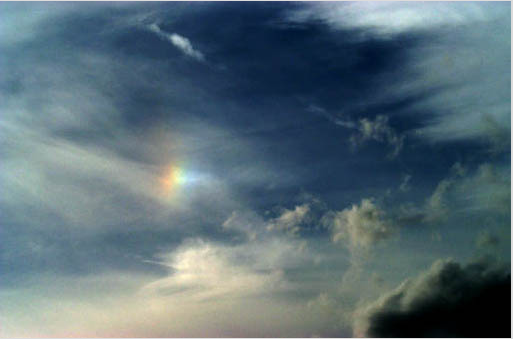Sundogs, England
Sundogs in England: A Spectacular Atmospheric Phenomenon
Sundogs, also known as parhelia, are a captivating atmospheric optical phenomenon that can be observed in various parts of the world, including England. These mesmerizing celestial displays occur when sunlight passes through ice crystals suspended in the Earth's atmosphere. While sundogs are relatively rare occurrences, they are truly a sight to behold when they do appear.
What Are Sundogs?
Sundogs are bright spots of light that appear on either side of the Sun, forming a halo-like effect. They are created by the refraction, reflection, and dispersion of sunlight by hexagonal ice crystals found in high-altitude cirrus clouds. These ice crystals act as prisms, bending the light and separating it into its component colors. As a result, sundogs often exhibit a vibrant range of hues, including red, orange, yellow, and blue.
The Formation of Sundogs
The formation of sundogs requires specific atmospheric conditions. They typically occur when there are thin, high-altitude cirrus clouds composed of ice crystals. These clouds act as a canvas for the intricate dance of sunlight and ice crystals that give rise to sundogs. The hexagonal shape of the ice crystals is crucial in producing the distinct halo-like effect observed around the Sun.
The Appearance of Sundogs
Sundogs appear as bright spots of light positioned at an angle of approximately 22 degrees from the Sun. They are often located on both sides of the Sun, forming a triangular configuration. The inner edge of each sundog is usually red, while the outer edge appears bluish. This color gradient is a result of the dispersion of sunlight by the ice crystals, with shorter wavelengths being scattered more than longer wavelengths.
Observing Sundogs in England
While sundogs can be observed in various locations around the world, England is no exception to this celestial phenomenon. The occurrence of sundogs in England is more common during winter months when the presence of cirrus clouds is more prevalent. However, they can also appear during other seasons, especially when atmospheric conditions are favorable.
Tips for Spotting Sundogs
If you're eager to witness the awe-inspiring beauty of sundogs in England, here are a few tips to enhance your chances of spotting them:
- Look for high-altitude cirrus clouds: Sundogs are more likely to occur when thin, wispy cirrus clouds are present in the sky.
- Position yourself correctly: Stand facing the Sun, and look for bright spots of light on either side, approximately 22 degrees away.
- Be patient: Sundogs may appear and disappear relatively quickly, so it's important to be patient and observant.
Sundogs and Other Atmospheric Phenomena
Sundogs are just one example of the myriad of atmospheric optical phenomena that can occur. Other related phenomena include halos, rainbows, and iridescent clouds. Each of these phenomena is caused by the interaction of sunlight with different atmospheric conditions and particles.
The Scientific Significance of Sundogs
Beyond their aesthetic appeal, sundogs also have scientific significance. Studying these atmospheric optical phenomena can provide valuable insights into the composition and behavior of high-altitude cirrus clouds. By understanding the formation and characteristics of sundogs, scientists can gain a deeper understanding of the Earth's atmosphere and its complex interactions with light.
Capturing the Beauty of Sundogs
Photographing sundogs can be a rewarding endeavor for those interested in capturing the beauty of these ethereal displays. To capture the vibrant colors and intricate details of sundogs, it is essential to use a camera with manual settings and experiment with different exposure settings. Additionally, polarizing filters can help reduce glare and enhance the contrast of the sundogs against the sky.
Conclusion
Sundogs are a captivating and enchanting atmospheric phenomenon that can be observed in England. These celestial displays, formed by the interaction of sunlight with ice crystals in high-altitude cirrus clouds, create stunning halos of light around the Sun. By understanding the conditions necessary for their formation and learning to spot them, we can appreciate the beauty of sundogs and gain insights into the complexities of our atmosphere. So, keep your eyes on the sky, and you may be fortunate enough to witness the breathtaking splendor of sundogs in England.

Bright parhelion imaged in Northern England 8th September 2000 by Bob Fosbury. The lower image was taken within a few minutes. Sundogs and indeed all halos can quickly alter in appearance as the host cirrus changes. ©Bob Fosbury, reproduced with permission.

Note: this article has been automatically converted from the old site and may not appear as intended. You can find the original article here.
Reference Atmospheric Optics
If you use any of the definitions, information, or data presented on Atmospheric Optics, please copy the link or reference below to properly credit us as the reference source. Thank you!
-
<a href="https://atoptics.co.uk/blog/sundogs-england/">Sundogs, England </a>
-
"Sundogs, England ". Atmospheric Optics. Accessed on November 26, 2024. https://atoptics.co.uk/blog/sundogs-england/.
-
"Sundogs, England ". Atmospheric Optics, https://atoptics.co.uk/blog/sundogs-england/. Accessed 26 November, 2024
-
Sundogs, England . Atmospheric Optics. Retrieved from https://atoptics.co.uk/blog/sundogs-england/.